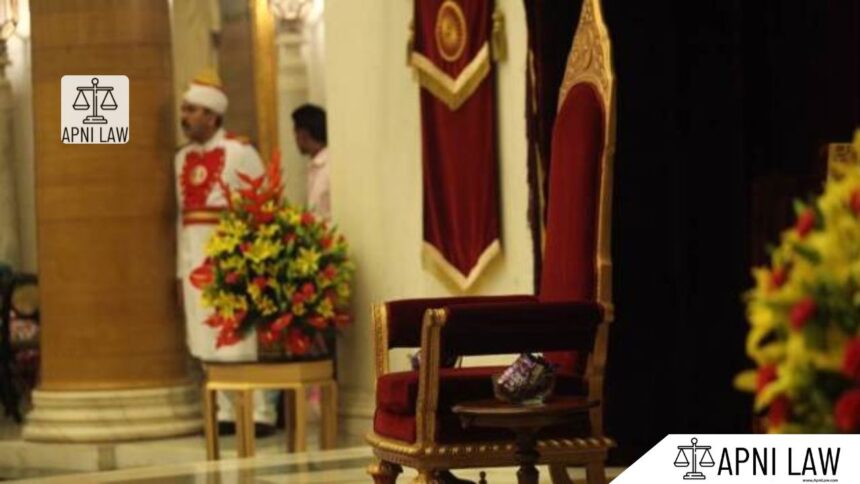Introduction
The Vice-President of India holds the second-highest constitutional office in the country. The position combines both political and parliamentary responsibilities. The Vice-President is also the ex-officio Chairman of the Rajya Sabha. This role gives the officeholder authority to preside over the upper house of Parliament, maintain discipline, and ensure smooth legislative functioning.
The Vice-President serves as a link between the legislative and executive branches. In the absence of the President due to death, resignation, removal, or inability, the Vice-President acts as the President until a new election is held. This arrangement reflects the importance of the office in maintaining constitutional continuity.
How is the Vice-President Elected?
The Vice-President of India is elected by an electoral college consisting of all members of both Houses of Parliament. Unlike the President’s election, the Vice-President’s electoral college does not include state legislatures. Both elected and nominated members of the Lok Sabha and Rajya Sabha participate. This distinction underlines the parliamentary nature of the post.
The election follows the system of proportional representation by means of the single transferable vote. Voting takes place through a secret ballot. Members rank candidates in order of preference. If no candidate secures the required quota in the first count, the least-voted candidate is eliminated, and the votes are transferred based on the next preferences. This process continues until a candidate crosses the quota.
The Election Commission of India conducts the election. The Commission issues the notification, supervises the polling process, and declares the result. Its role ensures neutrality, transparency, and fairness.
What are the Eligibility Conditions to Become Vice-President?
The Constitution lays down clear qualifications for a person to contest the election. A candidate must be:
- A citizen of India.
- At least 35 years of age.
- Eligible for election as a member of the Rajya Sabha.
- Free from holding any office of profit under the Government of India, state government, or any local authority.
These conditions aim to ensure that the Vice-President has maturity, experience, and independence. They also reflect the similarity of qualifications between the Vice-President and the President, with the difference being that the Vice-President must qualify for the Rajya Sabha while the President must qualify for the Lok Sabha.
What is the Term of Office of the Vice-President?
The Vice-President of India holds office for a term of five years from the date of assuming office. However, the Vice-President may continue beyond the term until a successor assumes charge. This provision prevents any constitutional vacuum.
The Vice-President can seek re-election for subsequent terms. The Constitution does not restrict the number of times a person may contest. So far, only Dr. S. Radhakrishnan and Mohammad Hamid Ansari have served two consecutive terms.
Can the Vice-President Resign from Office?
Yes, the Vice-President can resign at any time. The resignation must be addressed to the President of India. Once accepted, the office becomes vacant, and a new election must be held. The Constitution also provides that in case of resignation, death, or removal, the office cannot remain vacant for more than six months.
How is the Vice-President Removed from Office?
The Constitution provides a distinct method for the removal of the Vice-President. The process is not termed impeachment. It is different from the President’s removal.
The Vice-President can be removed by a resolution of the Rajya Sabha. The resolution must be passed by an absolute majority of its members. After this, the resolution must be agreed to by the Lok Sabha. A minimum of 14 days’ notice is required before moving such a resolution.
Interestingly, the Constitution does not prescribe specific grounds for removal. Unlike the President, who can only be removed for violation of the Constitution, the Vice-President can be removed without any such restriction. The flexibility ensures that Parliament can act if the Vice-President loses the confidence of members.
Additionally, the Supreme Court of India has the authority to remove the Vice-President if it declares the election void. Any dispute related to the election of the Vice-President can only be decided by the Supreme Court, whose decision is final.
Why is the Process Different from the President’s Impeachment?
The President of India represents the nation as a whole. Therefore, removal requires a lengthy process involving both Houses of Parliament and a strict majority. In contrast, the Vice-President functions mainly as the presiding officer of the Rajya Sabha and a constitutional backup for the President.
Since the Vice-President’s role is more parliamentary in nature, the framers of the Constitution decided to keep the removal process simpler. The requirement of an absolute majority in the Rajya Sabha and agreement of the Lok Sabha ensures seriousness without creating unnecessary rigidity.
What Happens When the Office of Vice-President Falls Vacant?
If the Vice-President resigns, dies, or is removed, the office becomes vacant. The Constitution requires that a new election must take place within six months. Until then, the duties of the Vice-President as Chairman of the Rajya Sabha are carried out by the Deputy Chairman of the Rajya Sabha or another member appointed by the President.
If the Vice-President is required to act as the President, the office of Vice-President does not become vacant. The Vice-President temporarily discharges the functions of the President until a new President is elected within six months.
What is the Historical Background of the Vice-President’s Office?
The office of the Vice-President did not exist in the original plans of the Constituent Assembly. It was later introduced to ensure that there is always a constitutional authority to act as Chairman of the Rajya Sabha and to step in if the President’s office falls vacant.
Dr. S. Radhakrishnan became the first Vice-President of India in 1952. He later became the President. Several Vice-Presidents, including Zakir Hussain, V.V. Giri, R. Venkataraman, Shankar Dayal Sharma, and K.R. Narayanan, have also gone on to become Presidents. This shows the importance of the office as a stepping stone to the highest constitutional position.
How Important is the Vice-President in Indian Politics?
The Vice-President’s role as Chairman of the Rajya Sabha is crucial. The officeholder manages debates, maintains order, and ensures smooth passage of legislation. In a country with a bicameral system, this function helps in balancing the working of Parliament.
The Vice-President also represents India at several national and international forums. Although the position is largely ceremonial in executive matters, it holds immense value in maintaining parliamentary decorum and constitutional balance.
For any specific query call at +91 – 8569843472
Conclusion
The Vice-President of India occupies a unique constitutional space. The election takes place through an electoral college of both Houses of Parliament, and the Election Commission ensures fairness. The office carries a five-year term, with the possibility of re-election. Removal is possible through a resolution of the Rajya Sabha agreed to by the Lok Sabha, without any prescribed grounds.
The Vice-President functions as the guardian of the Rajya Sabha and as the constitutional backup for the President. Though the role may appear limited, it provides stability, continuity, and balance in India’s parliamentary democracy. The history of several Vice-Presidents later becoming Presidents highlights its importance. Ultimately, the Vice-President symbolizes the principle that constitutional offices in India are interconnected and that no gap is allowed in the functioning of the highest institutions.







